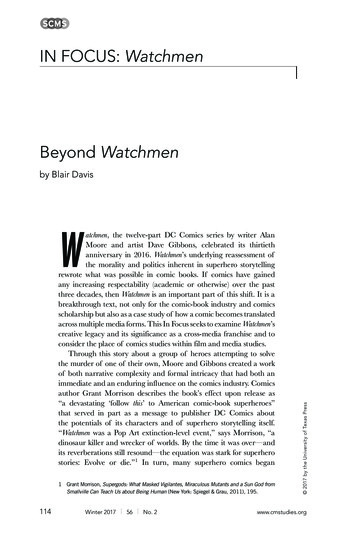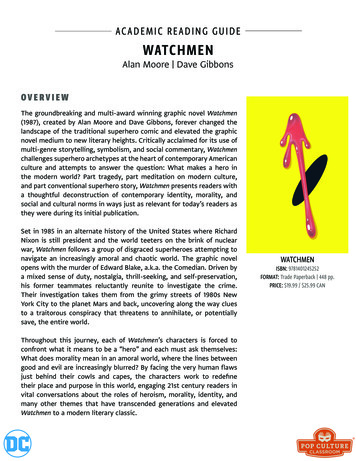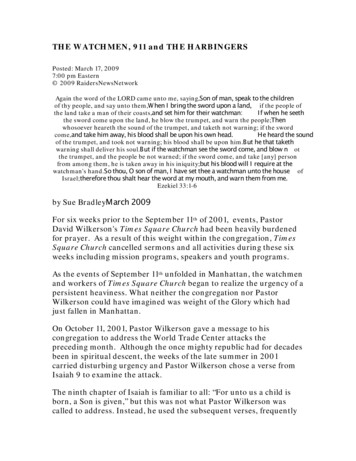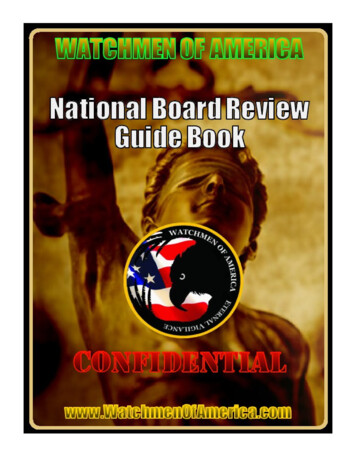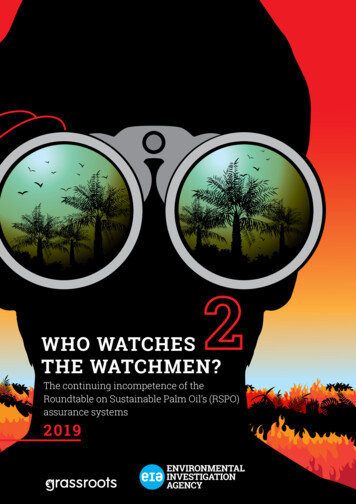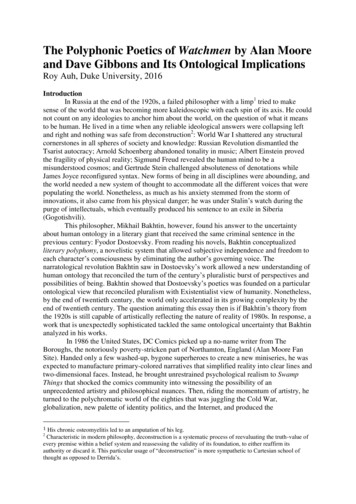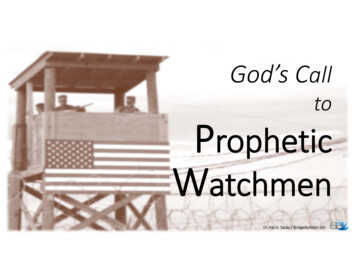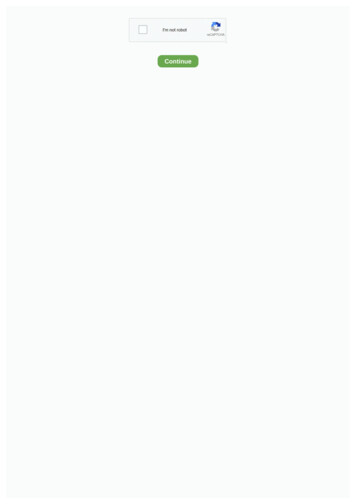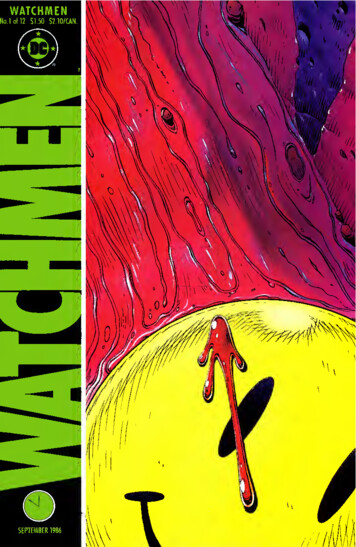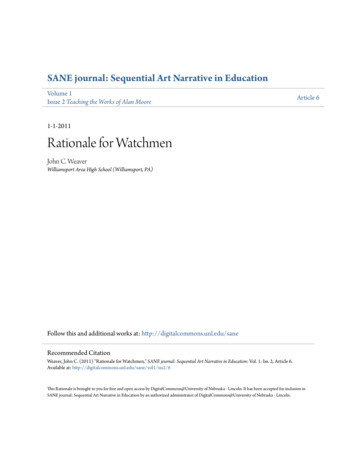
Transcription
SANE journal: Sequential Art Narrative in EducationVolume 1Issue 2 Teaching the Works of Alan MooreArticle 61-1-2011Rationale for WatchmenJohn C. WeaverWilliamsport Area High School (Williamsport, PA)Follow this and additional works at: http://digitalcommons.unl.edu/saneRecommended CitationWeaver, John C. (2011) "Rationale for Watchmen," SANE journal: Sequential Art Narrative in Education: Vol. 1: Iss. 2, Article 6.Available at: http://digitalcommons.unl.edu/sane/vol1/iss2/6This Rationale is brought to you for free and open access by DigitalCommons@University of Nebraska - Lincoln. It has been accepted for inclusion inSANE journal: Sequential Art Narrative in Education by an authorized administrator of DigitalCommons@University of Nebraska - Lincoln.
Weaver: Rationale for Watchmen47WatchmenBy Alan Moore and Dave GibbonsRationale by John C. Weaver, Williamsport Area High School (Williamsport, Pennsylvania)Grade Level and AudienceWatchmen is recommended for mature high school junior and senior English classes.Plot SummaryIn 1985, in an alternate United States, Nixon is still president and the Soviet Unioninvades Afghanistan, driving the Soviets and the Americans to the brink of nuclear war.Against this backdrop, the masked vigilante Rorschach, wanted by the police for hismurder of several criminals, investigates the homicide of another former vigilante, theComedian.Rorschach warns several other masked adventurers, whose activities were outlawed in thewake of the police strike of 1977, that their lives may be in danger: Dan Dreiberg (theNite Owl), Laurie Juspeczyk (Silk Specter), Adrian Veidt (Ozymandias), and JonOsterman (Dr. Manhattan). The former superheroes do not take Rorschach’s warningsseriously.But soon, an assassination attempt is made against Adrian’s life; Dr. Manhattan, thenovel’s only superpowered being and America’s main nuclear deterrent, leaves Earth forMars after being accused of causing cancer in his old friends; and Rorschach is set up forthe murder of a retired supervillain and arrested.As tensions between the U.S. and the Soviet Union escalate and nuclear war becomes amore distinct possibility, Dan and Laurie don their old costumes and continueRorschach’s investigation. They break Rorschach out of prison, and Laurie tries toconvince her old lover, Dr. Manhattan, to save the world from nuclear holocaust whileDan and Rorschach trace the web of conspiracy to its center.By the end, we learn many secrets: about Laurie’s relationship to the dead Comedian andabout Adrian’s plan to avert nuclear war and remake the world in his own image. Dan,Rorschach, and Laurie could not face a more dangerous opponent than Adrian Veidt.Strengths and Unique Characteristics of the WorkWatchmen, with its rich language, its complex and interwoven themes, and the interplaybetween words and images, is the Hamlet of graphic novels. A critique of the comicbook superhero, Watchmen serves to question our notions of what is heroic. In additionto the graphic storyline, Moore adds at the end of the first eleven chapters a variety ofPublished by DigitalCommons@University of Nebraska - Lincoln, 20101
SANE journal: Sequential Art Narrative in Education, Vol. 1 [2010], Iss. 2, Art. 648prose genres, including memoire, magazine profiles, business letters, advertising copy,and political propaganda, which allows a teacher to examine the conventions of a widerange of genres.Perhaps most fascinating is Moore and Gibbons’ comic within a comic. Similar toHamlet’s Mousetrap play, Tales from the Black Freighter is a Watchmen in miniature,which intensifies and expands upon the themes in the larger novel.Possible ObjectionsViolence and sex are depicted graphically in Watchmen. In terms of violence, the fightscenes include large amounts of blood, and the final attack on New York shows streetsfilled with bloody dead bodies. Gibbons and Moore chose to create such a graphicdepiction in the last chapter to highlight the consequences of Adrian Veidt’s plan to savethe world by destroying Manhattan. It contrasts with his exalted image of a world ofpeace, love, and cooperation between nations.Sexuality, which is sometimes graphically depicted, appears either as a degrading activityor an expression of deep personal connection. There are representations of prostitution,mainly through silhouette, and references to some costumed heroes who are attracted tothe lifestyle for reasons that are decidedly sexual. Watchmen also represents theattempted rape of a female superhero. On the other hand, the sex depicted between Danand Laurie is presented as positive and tender, two people reaching out to each other.Watchmen also contains adult language. As well, some may see Dr. Manhattan as a Godfigure or find problems in the texts’ suggestion that God does not exist. The text alsoexpresses a range of political views, from conservative to liberal. It critiques all of them,but some many find concern with some characters’ beliefs or ethics. While it exploresmany mature themes, Watchmen is not a text that offers answers so much as it offersmultiple critiques and raises questions of every form: moral, historic, philosophical,political, religious, etc.Ideas for ImplementationTEACHING THE FORM OF COMICSAlthough a number of students will have read comics before, far more will have littleexperience with graphic fiction. You may wish to introduce the form by examiningsimple one to four panel newspaper strips, such as Dilbert, Peanuts1, Bloom County2, andso on. Most students will have read newspaper strips and will feel comfortable with theform. You may discuss the interplay of text and image and the flow from panel to panelto prepare them for the complexity of graphic novels.To further prepare students for Watchmen, consider teaching Scott McCloud’sUnderstanding Comics, particularly chapter 3, which examines the different types ofhttp://digitalcommons.unl.edu/sane/vol1/iss2/62
Weaver: Rationale for Watchmen49transitions from panel to panel. Applying McCloud’s ideas to the newspaper strips wouldbe useful for your students to understand how comics work in the small scale beforemoving to a full graphic novel.CREATING BACKGROUND KNOWLEDGEWatchmen, written in the 1980s and located in that particular historical moment, requiressome prior knowledge of the Cold War. So that the class may understand the novel,small group research projects, leading to class presentations, effectively transmit thenecessary background knowledge students will need to fully appreciate the novel. Suchtopics may include the Manhattan Project, the Soviet/U.S. arms race, the Soviet invasionof Afghanistan, Bernard Goetz (as an example of vigilantism), and other topics you findrelevant to the text.TRACING THE THEMES OF WATCHMENWhile your students read Watchmen, as with any other text, they should watch out forquestions that emerge, including what makes a character heroic or criminal. Somecharacters, like Rorschach and the Comedian, appear more violent than the criminals theybattle. A corollary idea to consider in their reading is what constitutes justice, and can avigilante really represent justice? By the end of the story, when Adrian Veidt killsmillions of New Yorkers to avert worldwide nuclear catastrophe, your students mayengage in a lively debate as to whether the ends ever justify the means.Those who choose to examine the more philosophical side of the novel should considerthe questions raised by Dr. Manhattan. This character experiences time as simultaneous:Dr. Manhattan sees his past, present, and future as a single time. Though he foresaw theKennedy assassination, he did nothing to stop it, because to him it was something thatalready happened. Students may find it useful to discuss whether the future ispredetermined, or if we have the power to shape our destiny. If the former is true, thenwhat happens to our sense of personal responsibility?Of course, one must also consider the graphic aspects of Watchmen. Not only does theart clarify the emotions inscribed in the dialogue, but Moore and Gibbons also usedialogue from one conversation and juxtapose it with the action of another scene. Thepirate comic, Tales of the Dark Freighter, has particular relevance to the main action ofWatchmen. The Mariner in the comic is shipwrecked and the pirates who attacked hisship are threatening his hometown. To save his wife and children, he must try to gethome, and the horrors he faces along the way have deep connections to both Rorschach’sand Adrian Veidt’s story.Ideas for Thematic BraidingsFundamentally, Watchmen is a critique of the heroic ideal. In western civilization, weoften see the hero as a individual who is stronger, braver, and often more intelligent thanPublished by DigitalCommons@University of Nebraska - Lincoln, 20103
SANE journal: Sequential Art Narrative in Education, Vol. 1 [2010], Iss. 2, Art. 650the rest of us. They represent the highest ideals of their culture. Watchmen examines atwentieth century ideal of the hero—the superhero—and questions the whole idea ofheroism. The costumed adventurers believe that they are there to protect society, butinstead, many are either more violent than the criminals they fight or they are ineffectual.Nearly all dress up in costume for their own agendas, and not for the good of society.Therefore, Watchmen would work very well in a unit on the heroic idea. Braiding thecritique of heroism in Moore and Gibbon’s novel with texts like Beowulf, the Song ofRoland, or The Odyssey, which represent typical western heroic ideas, would be a usefulexercise. The reason such a unit would be particularly powerful is that once yourstudents look at the self-serving nature of the hero in Watchmen, they may identify thesame flaws in Beowulf, Roland, or Odysseus. Watchmen has the tendency to make allstories of heroes look like critiques of the heroic ideal.Another, very different, unit would be one on dystopias. Novels like Brave New World,1984, and The Giver have some connections to Watchmen. The graphic novel exists inan alternate United States in 1985, where costumed adventurers exist and attempt to makethe world a better place, and generally fail miserably. The other dystopic novels alsoillustrate the horrible societies that result from the attempt to make the world a betterplace.Awards1988 Hugo Award31988 Eisner Award for Best Finite Series41988 Eisner Award for Best Writer: Alan MooreResources/ReferencesGeneral:The annotated Watchmen, A chapter-by-chapter 1.htmlWatchmen Companion Reader: .cfmWatchmen at blication and receptionAcademic Articles:Brandy Ball Blake’s “Watchmen: The Graphic Novel as Trauma chives/v5 1/blake/Mark Bernard and James Bucky Carter’s “Alan Moore and the Graphic novel:Confronting the Fourth hives/v1 ss2/64
Weaver: Rationale for Watchmen51Teaching The Text:James Bucky Carter’s “Teaching Watchmen in the Wake of 9/11” in Teaching theGraphic Novel: http://www.mla.org/store/CID44/PID390John Weaver Teaches Watchmen to High ent/who-teaches-watchmen-op-ed eaching-watchmen-op-ed1http://www.comics.com/ This site offers many different comic strips to choose from to introducestudents to graphic s/favorite /cci eisners pastwinners.php - 19883For rationales for teaching 107 more graphic novels, see this resource:available at http://maupinhouse.com/Published by DigitalCommons@University of Nebraska - Lincoln, 20105
Watchmen, with its rich language, its complex and interwoven themes, and the interplay between words and images, is the Hamlet of graphic novels. A critique of the comic book superhero, Watchmen serves to question our notions of what is heroic. In addition to the graphic storyline, Moore adds at the end of the first eleven chapters a variety of 1 Weaver: Rationale for Watchmen Published by .
